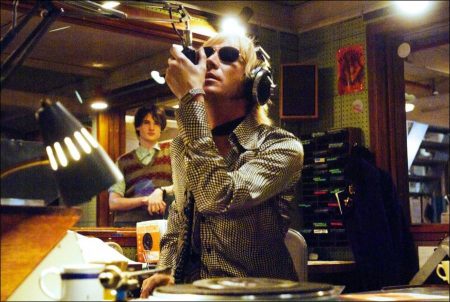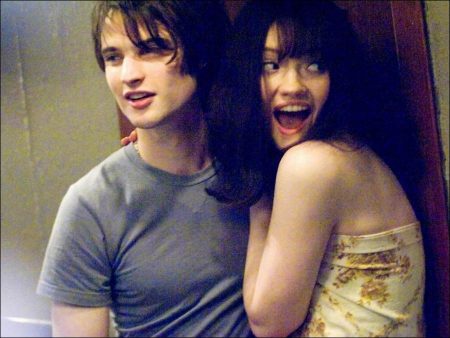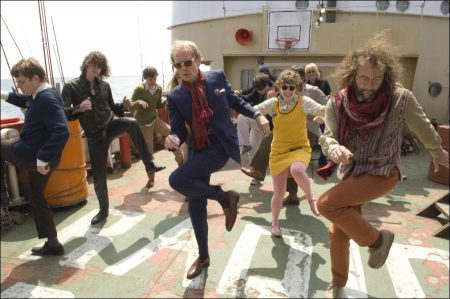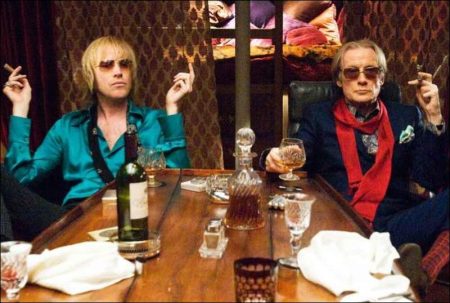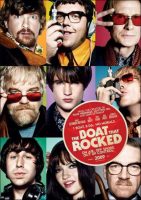Taglines: On air. Off shore. Out of control.
The Boat That Rocked movie storyline. In 1966-British pop music’s finest era-the BBC played just two hours of rock and roll every week. But pirate radio played rock and pop from the high seas 24 hours a day. And 25 million people-more than half the population of Britain-listened to the pirates every single day. Recently expelled from school, Carl (Tom Sturridge) has been sent by his mother to find some direction in life by visiting his godfather, Quentin (Bill Nighy). However, Quentin is the boss of Radio Rock, a pirate radio station in the middle of the North Sea, populated by an eclectic crew of rock-and-roll deejays.
They are led by The Count (Philip Seymour Hoffman)-big, brash, American god of the airwaves and totally in love with the music. He’s faithfully backed up by his co-broadcasters Dave (Nick Frost)-ironic, intelligent and cruelly funny; Simon (Chris O’Dowd)-super-nice and searching for true love; Midnight Mark (Tom Wisdom)-enigmatic, handsome and a man of few words; Wee Small Hours Bob (Ralph Brown)-the late-night deejay, whose hobbies are folk music and drugs; Thick Kevin (Tom Brooke)-possessor of the smallest intelligence known to mankind; On-the-Hour John (Will Adamsdale)-the newsreader; and Angus “The Nut” Nutsford (Rhys Darby)-possibly the most annoying man in Britain.
Life on the North Sea is eventful. Simon finds the woman of his dreams, Elenore (January Jones), and is married on the boat…only to be left by his bride the next day. Gavin (Rhys Ifans) returns from his drug tour of America to his rightful position as greatest deejay in Britain and, in doing so, clashes with The Count. And Carl discovers the opposite sex and who his real father is.
Meanwhile, pirate stations have come to the attention of government minister Dormandy (Kenneth Branagh), who is out for the blood of these lawbreakers. In an era when the stuffy corridors of power stifle anything approaching youthful exuberance, Dormandy seizes the chance to score a political goal, and The Marine Broadcasting Offences Act is passed in an effort to outlaw the pirates and to remove their ghastly influence from the land once and for all. What results is a literal storm on the high seas. With Radio Rock in peril, its devoted fans rally together and stage an epic Dunkirk-style hundred-boat rescue to save their deejay heroes. Some things may come to an end, but rock and roll never dies.
Rocking the Boat
“Here’s the simple situation: Already the authorities dislike us. If you do this, they will hate us and- by hook or by crook-they will find a way to close us down.” – Quentin
After the worldwide success of his directorial debut, Love Actually, Richard Curtis began to consider ideas for his next film. As he imagined new stories, Curtis reflected on memories from his childhood of late nights listening to rogue rock-and-roll deejays who broadcast from ships and marine structures anchored just outside U.K. territorial waters in the late 1960s.
These radio stations introduced enormous and enthusiastic audiences to landmark acts such as The Beatles, The Rolling Stones and The Kinks, as well as legendary solo artists including Jimmy Hendrix, Dusty Springfield, Janis Joplin and Aretha Franklin. The piracy was much to the chagrin of the government, which did its very best to suppress illegal transmissions coming from the waters to the homes of millions of Brits who loved everything they heard.
Curtis’ passion for music from that era was evident throughout Love Actually-from songs by Joni Mitchell and Darlene Love to tunes written by Paul Anka and Lennon / McCartney. It seemed only fitting his next movie would fully embrace his love of music from the late ’60s. He would set his tale on a pirate radio ship and ensure his favourite songs made up the soundtrack.
“Every person in my generation has the same memory,” recalls Curtis. “You would go to bed at night and put your transistor radio underneath your pillow, switch it on and hear this fantastic music you could not hear elsewhere. And your parents would shout from downstairs,`Go to bed! Turn off the light; go to sleep!’ It was one of the things that made me love pop music most, that slight sense of it being illicit and illegal.”
Duly inspired by Robert Altman’s cult classic M*A*S*H and John Landis’ landmark Animal House, Curtis aimed to capture the essence of those comedies in his new project. M*A*S*H, with its informality and loose structure, and Animal House, with its maniacal and irreverent jokes, shared the male bonding and comedic situations Curtis guessed occurred on the offshore boats. He explains: “I started to write down a few scenes of things that could go wrong on a boat with a lot of guys on it. You immediately start to think: What is the relationship of the guys with girls? Do girls come over once a fortnight to have sex with the guys? What happens if someone wants a girlfriend? How do you get a girlfriend?”
Armed with many questions, sense memories and loads of time at the computer, Curtis crafted The Boat That Rocked as a coming-of-age tale that centers upon Carl, an 18-year-old who has been expelled from school and sent to live with his godfather, Quentin, on a lawless boat in the North Sea. The virgin is looking for answers to life’s questions, and his free-spirited mother feels he’ll find many of them on the vessel. His journey would take him to, as Curtis puts it, “ramshackle boats in the middle of the sea, with disc jockeys with massive egos-living and breathing and doing their shows 24 hours a day.”
Screenplay in hand, Curtis took the project to longtime collaborators, Working Title’s Tim Bevan and Eric Fellner. “The music, the period, the story and everything about the project was of huge interest to us,” recalls Fellner. “Tim and I, and all of us at Working Title, have been very lucky to have an ongoing relationship with Richard going back about 15 years. It’s always exciting making a film with him. He is a wonderfully charismatic, creative individual.”
Producer Hilary Bevan Jones had previously worked with Curtis on the award-winning television drama The Girl in the Café, starring Bill Nighy and Kelly Macdonald, and was a natural choice to join the team of The Boat That Rocked. “I read the script and fell in love with it immediately,” recalls Bevan Jones. “There were lots of ingredients that made it irresistible. It was funny, touching, and the music was fantastic. Richard’s films have such a huge heart. You can’t but feel warmth when you watch his work.”
All Those Waves: Shooting on Water
“My aim is not to offend. It is to entertain and also, perhaps, to educate a little. Because if you shoot a bullet, someone dies. When you drop a bomb, many die. If you hit a woman, love dies. But-and this is my profound and political point- if you say the `f’ word, nothing actually happens.” – The Count
As he transitioned from one role to another, Curtis considered the enormity of the task in front of him. He notes, “When you write, you worry about making the film. It was a fantastic moment when we finished the script to think, `Oh my God. Now if this is the film we’re going to make, we’ve actually got to find a great, big hulking boat, all the actors have to learn how to be disc jockeys…and something quite exciting happens at the end of the film.
“That’s where you get an amusing disconnect between writer and director,” he continues. “The writer writes what he likes, and then the poor director takes receipt of it. But it was an extraordinarily fun film to make because we did have to get a real boat and go out on that boat and film in real weather. We put a village onto it-140 people: makeup, catering, costume, actors and crew-and sailed out from a harbour every day for five weeks. No matter what the weather, we shot whatever we could on this rusty old boat rented from placecountry-regionScotland.”
To prepare the actors for life on Radio Rock, Curtis sent much of the cast to a “boat camp,” which involved living and rehearsing on the boat on which they would be filming. Cast and crew slept in small cabins on the boat and rehearsed throughout the day. In the evening they would eat, drink and play darts or table football. “It really worked as a bonding exercise,” notes Rhys Ifans. “We discovered very early on we had quite a special cast, and we got very close.”
To ready the team for the type of movie they would be making, Curtis screened Robert Altman’s M*A*S*H during rehearsals. That film has stayed in my mind all the way through shooting,” says deejay Bob, aka Ralph Brown. “There’s a feeling of community between the characters in M*A*S*H similar to what we were trying to achieve-an added texture of overheard conversations and moments of interaction. There’s a sense that the camera is watching something happening in front of it, rather than it being staged. That’s very much what Richard wanted to do with this film.”
To assist the actors in their transition into credible disc jockeys, Emma Freud and deejay technical advisor John Revell worked with the cast in a mock radio studio in London. They met with ex-pirate radio deejay Johnny Walker, as well as deejay Chris Evans, in a working studio to study various styles of broadcasting. By the end of their training, the actors had to record an hour-long show that was to be used in the film.
“This was brilliant,” remembers Curtis. “Not only because we ended up filming the hour of their show, but also because it made them understand the relationship between who they were as a public person and who they were in private. If they had not practiced their show, they would not realize how powerful you feel when you are a disc jockey broadcasting entirely on your own to 25 million people for two hours a day.”
“It’s hard learning how to deejay,” adds Freud, who regularly works on the radio.“You have to find a voice that is true and honest, but also interesting and funny and worth listening to. It made it doubly hard for the actors because they weren’t deejaying as themselves, but as their characters in the film. So we taught them the technical side first, queuing up records and working the cart machines. Then during the rehearsals, they found their voice.”
Because of scheduling commitments, Philip Seymour Hoffman started on the production several weeks after the shoot began. This didn’t allow him the luxury of long rehearsals and radio training the other cast enjoyed. “He arrived on set and had one hour in which to learn how to be a deejay,” recalls Freud. “He was so wonderful at the mic that he looked like he had been doing it all his life. We worked out that his character would stand up during a show, and he held the mic in such a gorgeous way when he broadcasted. It set his character apart from the other deejay’s styles.”
Principal photography began on March 3, 2008, and The Boat That Rocked filmed for a total of 14 weeks. Five of those weeks took place in Portland Harbour, Dorset, shooting on a boat called the Timor Challenger.
Of the search to find the Timor Challengers, production designer Mark Tildesley recalls: “It was quite difficult to find a suitable boat to film on. We were looking for a craft that was seaworthy, one that could accommodate a certain number of crew and had the right look for the period. A lot of the boats we liked didn’t have working engines.”
The search ended in Scotland when the filmmakers found the placeTimor, which began life as a deep-sea fishing trawler, then became a hospital boat and was finally adapted to serve as a rescue boat for the oil rigs. To make the placeTimor look as if it was a functioning pirate radio station ship, two huge aerial masts were erected on the deck.
“Having masts did cause a few problems,” admits Tildesley. “We could only film in calm conditions, because if it was really rough, we could not leave the harbour.” Luckily, during the five-week shoot the weather was kind, and only three days were disrupted by bad weather. Two sets were built in a warehouse next door to the dock, and during these three inclement days, filming continued on shore.
“There is a saying in the film industry: `Don’t work with children, animals or on water,’” laughs Bevan Jones. “When there is water around you, it can essentially be a disruptive character. It would take us 45 minutes to get out to sea-and even longer to return to harbour-so our days were really long. The current and the wind would constantly move the boat, and we had to have tugboats keeping the Timor Challenger in position…so that the land did not get in shot.”
The choppy waters weren’t only a distraction to the plans mapped out by Curtis and cinematographer Danny Cohen. Bevan Jones explains that a queasiness factor inserted itself into every step of the production: “We also had to make sure cast and crew had been armed with seasickness pills, as it could be quite rough at times.”
Filming some interiors of the boat took place on sets built at Shepperton and Pinewood Studios outside of London. To re-create the movement of the sea, the sets built were built on a hydraulic gimble that could provide just the rocking motions the filmmakers required. Curtis, DP Cohen and designer Tildesley believed re-creating and shooting in close corridors and little rooms would prove a challenge, but that much comedy could come from big egos trapped in tiny spaces.
As an example, Dave and Carl have a hurried conversation in the WC about Carl’s pathetic love life (before Dave’s girlfriend walks in). The scene was, naturally, shot in the smallest space Tildesley could build. Curtis recalls, “I said to Mark that it’s got to be a real cabin bathroom. It’ll be absolutely tiny; it should be difficult to fit the three people in. So Mark made the tiniest room possible. Sure enough, when we shot the scene, it was difficult to fit the three people in, particularly if one of them’s Nick Frost. Then, we thought, `Where are you going to put the cameraman and the soundman?’ So we took away a little wall, but it was still fantastically crowded.”
Curtis knew the traditional style of shooting wouldn’t work well on a boat with narrow passageways. He and DP Cohen agreed that they should “have two guys with cameras on their shoulders wandering around, picking different positions so that anyone who sees the film will see Radio Rock is intended to be very informal, very chaotic. There is no question of holding the line that people are looking down, no wide shot or close shot. The camera just moves around wherever it can.”
For the cast, it was (despite occasional tight quarters) quite refreshing to leave sound stages and closed sets to film out on the open seas. Curtis ensured rock and roll permeated the production, and sounds of the ’60s were played on the journeys to and from the port. For some members of the cast and crew, there was even a bit of time for fishing during breaks in the day.
The Kinks to The Who: Music of the Film
Longtime Working Title Films and Richard Curtis collaborator, music supervisor Nick Angel worked hand in hand with Curtis to bring some of the best sounds from the 1960s to the big screen in The Boat That Rocked. “Richard has worn his heart on his sleeve for this film, and the music is an integral part of it” says Angel. “Quite simply, it’s music that Richard loves, and my job was to make sure that we got the songs he wanted in the film.”
The process started some two years ago when Curtis first mentioned to Angel that he was writing a film based around the world of pirate radio set in 1966 and 1967. Angel, who had worked closely with the director before on Notting Hill and Love Actually, began to gather songs he felt might be used in creating the film.
He recounts, “I made Richard some CDs featuring tracks I liked and ones I thought were interesting from that period-things that he could listen to while he was writing. Richard loves music, so he obviously had his own ideas. But with some tracks, I wanted to jog his memory.”
At this stage, the two men began to collect a catalogue of some 200 songs that were potential contenders to make it into the film. To help his castmembers brush up on their Chris Farlowe, Troggs, Supremes and Turtles, Curtis gave the burgeoning deejays iPods crammed with his and Angel’s choice selection of tracks from the ’60s.
“We wanted to give the actors a flavor of the music that their characters would have been into,” Angel relates. “We can’t assume that a 23-year-old is going to be that familiar with 1966 and 1967. And even if they were, everybody has gaps in their music knowledge.
As the start of principal photography approached, the song list was whittled down to around 70 that were still in contention. After the footage was shot and the editing process began, Curtis and music editor Steve Price put together the musical jigsaw and married select songs to fit specific scenes and moods. In all, 54 songs feature in the finished film.
“That’s quite a lot,” states the music supervisor. “But then, the story is set on board a pirate radio station, so there is music virtually all of the time. We’ve got a great blend. There are tracks that are very well known and loved, and there are others that are less well known.”
The result is a feast of vintage ’60s music featuring The Rolling Stones (“Jumpin’ Jack Flash” and “Let’s Spend The Night Together”), The Kinks (“All Day and All of the Night”), The Who (“My Generation,” “I Can See For Miles,” and “Won’t Get Fooled Again”), Small Faces (“Lazy Sunday Afternoon”), Jimi Hendrix (“The Wind Cries Mary”), Leonard Cohen (“So Long, Marianne”), The Supremes (“The Happening”), Otis Redding (“These Arms of Mine”), The Hollies (“I’m Alive”), Smokey Robinson and The Miracles (“Ooo Baby Baby”), as well as Sandie Shaw (“Girl Don’t Come”) and many more.
The soundtrack album is slated to feature 40 of the songs used in The Boat That Rocked. Triple Brit award-winning singer Duffy has recorded a version of “Stay With Me Baby” for the film. Additionally, Oscar-winning composer Hans Zimmer scored original music for a key section of the comedy.
“We got almost everything we wanted for the film,” Angel proudly states. “There were one or two tracks that, for various reasons, we couldn’t have, but there were always alternatives. We’re delighted with the result.”
****
Production wrapped, cast finally dry and Curtis and editor Emma Hickox hard at work in the editing bay, the team reflected on working on The Boat That Rocked and why Richard Curtis films seem to inspire a dose of levity.
“Richard has this gift of attracting people who don’t regularly go to the movies,” sums producer Fellner. “What that is, I’m not quite sure, but there seems to be a magical element to his movies that persuades people it would be good to go to the cinema-as they know that they’re going to enjoy the two hours that they spend under his spell.”
Of making a film that combines his love of music, comedy and romance, Curtis concludes: “This was a fantastic era of music, and it’s exciting to make a movie where you’ve got an excuse to put music over every single scene. I hope it’s going to be one of those films where, when you watch it, you immediately feel how lovely it would be to be amongst that bunch of people on that boat. One of the charms of Four Weddings was that you really felt you were amongst that group of friends. I hope this film will be like going for a very pleasant weekend with all the people in the world you most love when they are on really good form.”
The Boat That Rocked (2009)
Directed by: Richard Curtis
Starring: Tom Sturridge, Philip Seymour Hoffman, Bill Nighy, Nick Frost, Kenneth Branagh, Rhys Ifans, January Jones, Jack Davenport, Lucy Fleming, Charlie Rowe, Katherine Parkinson, Stephen Moore
Screenplay by: Richard Curtis
Production Design by: Mark Tildesley
Cinematography by: Danny Cohen
Film Editing by: Emma E. Hickox
Costume Design by: Joanna Johnston
Set Decoration by: Dominic Capon
Art Direction by: Thomas Brown, Rod McLean
Music by: Hans Zimmer
MPAA Rating: R for language, and some sexual content including brief nudity.
Distributed by: Universal Pictures
Release Date: August 28, 2009
Views: 115
